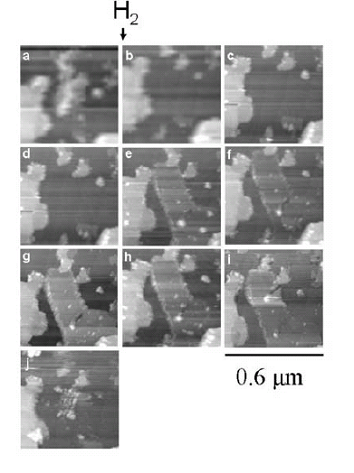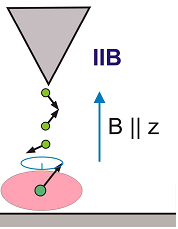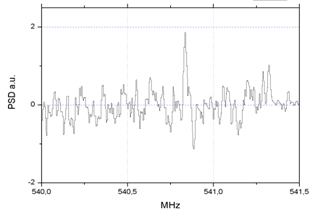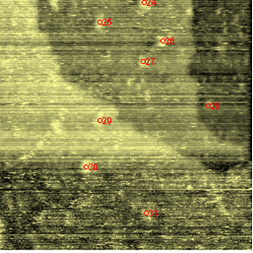Subsurface STM imaging of electrically floating islands
Yishay Manassen
We are studying hydrogen absorption and corrosion on a metal surface. The system studied was Gd on W(110). This system was exposed to several Langmuirs of hydrogen. In the image below we see a series of consecutive images taken above the same place. The time between two images is about ½ hour. The phenomenon which is clearly distinguishable is the periodic appearance and disappearance of several islands. Since the islands appear and disappear exactly in the same shape, it clear that the island is not vanishing but somehow becomes transparent to the STM imaging process. As seen below, in some cases, the STM tip is imaging the surface under the island.
The process that is causing this phenomenon is the fact that hydrogen creates an insulating barrier between the Gd island and the W substrate. Thus the island is disconnected electrically from the substrate. As a result, the potential of the island is floating and when it is equal to the potential of the tip, the island is becoming part of the tip and the surface under the island is imaged.
The periodicity of the process is due to a competition between the stress induced by the hydride nuclei seen in the island as white protrusions and the stress in the insulating layer between the tungsten substrate and the gadolinium island.

- Further reading:
- Surf. Sci. 600 2795 (2006).
Noise spectroscopy of a single spin
Yishay Manassen
We have found that tunneling with a STM (scanning tunneling microscope) to a surface in the neighborhood of a single paramagnetic atom or molecule (individual magnetic dipole) in the presence of an external magnetic field results in an elevated noise at the Larmor frequency. This high frequency noise results is due to the precession of a single magnetic dipole around the field (see Figure1).
The precession frequency depends strongly on the local environment of spin center, and can be used to identify molecules under the tip on the single molecule level. Fundamental information on the single spin physics is studied in this way. Additional potential applications are in single molecule data storage and quantum information.
Steps to improve the system which are implemented in these days, such as cooling to low temperature, working in time domain and scanning the field rather than the frequency are expected to improve the sensitivity of the detection system, to enable getting more information on the single spin physics.
 |
 |
 |
| Figure 1 | Figures 2,3: The image on the right is an image of a gold sample covered with DPPH molecule. The spectrum on the left is from the lowest molecule in the image (#31). We collaborate on this subject with a group from Italy and also with other groups around the world. | |
Further reading:
- J. Appl. Phys. 101, 053916 (2007)